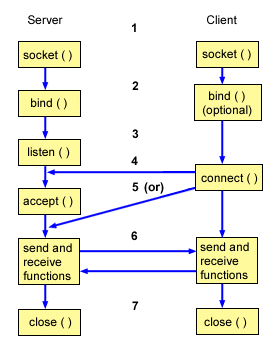## Java專題十二:網絡
[TOC]
### 12.1.套接字
- `Socket`: 客戶端套接字
- `ServerSocket`: 服務器端套接字
> Linux中Socket編程:[http://www.man7.org/linux/man-pages/man2/socket.2.html](http://www.man7.org/linux/man-pages/man2/socket.2.html)
<table >
<tr>
<th style="width:70%">SOCKET_API</th>
<th style="width:30%">DESCRIPTION</th>
</tr>
<tr>
<td>int socket(int domain, int type, int protocol);</td>
<td>create an endpoint for communication</td>
</tr>
<tr>
<td>int accept(int sockfd, struct sockaddr *addr, socklen_t *addrlen); </td>
<td>accept a connection on a socket</td>
</tr>
<tr>
<td> int connect(int sockfd, const struct sockaddr *addr, socklen_t addrlen);</td>
<td>initiate a connection on a socket</td>
</tr>
<tr>
<td> int bind(int sockfd, const struct sockaddr *add, socklen_t addrlen);</td>
<td>bind a name to a socket </td>
</tr>
<tr>
<td>int listen(int sockfd, int backlog);</td>
<td> listen for connections on a socket
</td>
</tr>
<tr>
<td>ssize_t send(int sockfd, const void *buf, size_t len, int flags); </td>
<td>send a message on a socket </td>
</tr>
<tr>
<td>ssize_t sendto(int sockfd, const void *buf, size_t len, int flags,
const struct sockaddr *dest_addr, socklen_t addrlen); </td>
<td>send a message on a socket </td>
</tr>
<tr>
<td>ssize_t recv(int sockfd, const void *buf, size_t len, int flags);</td>
<td>receive a message on a socket</td>
</tr>
<tr>
<td>ssize_t recvfrom(int sockfd, const void *buf, size_t len, int flags,
const struct sockaddr *dest_addr, socklen_t addrlen);</td>
<td>receive a message on a socket</td>
</tr>
<tr>
<td>ssize_t read(int fd, void *buf, size_t count); </td>
<td>read from a file descriptor</td>
</tr>
<tr>
<td>ssize_t write(int fd, const void *buf, size_t count); </td>
<td>write to a file descriptor</td>
</tr>
<tr>
<td>int close(int fd); </td>
<td>close a file descriptor</td>
</tr>
</table>
#### 12.1.1 服務器端(`java.net.ServerSocket`)
* 創建Socket(`new ServerSocket()`)
* 綁定端口(`bind(SocketAddress endpoint)`)
* 監聽端口(`accept()`)
* 等待客戶端連接
* 接收和發送數據(`getInputStream()、getOutputStream()`)
* 關閉Socket(`close()`)
#### 12.1.2客戶端(`java.net.Socket`)
* 創建Socket(`Socket()`)
* 發起連接(`connect(SocketAddress endpoint)`)
* 發送和接收數據(`getOutputStream()、getInputStream()`)
* 關閉Socket(`close()`)

### 12.2.高級API
java.net 包中的許多類可以提供更加高級的抽象,允許方便地訪問網絡上的資源。
- `URI`: 表示統一資源標識符(URI)引用
- `URL`: 表示統一資源定位器,即指向萬維網上“資源”的指針
- `URLConnection`: 表示應用程序和URL之間的通信鏈接
- `HttpURLConnection`: 支持HTTP特定功能的URLConnection,規范見[http://www.w3.org/pub/www/Protocols/](http://www.w3.org/pub/www/Protocols)
例:從網絡上下載文件并保存到本地,詳細參考[NetTools](https://github.com/15045120/git-docs/blob/master/tools/NetTools.java)
```
NetTools.download("https://dl.google.com/android/repository/platform-tools-latest-windows.zip","");
```
```
public static boolean download(String url, String saveDir)
throws URISyntaxException, IOException {
// get download file name
String fileName = url.substring(url.indexOf('/'));
if (saveDir == null || saveDir.trim().equals("")){
saveDir = "";
}else{
File out = new File(saveDir);
if (!out.exists() || !out.isDirectory()){
throw new FileNotFoundException();
}
}
// open connection
URI uri = new URI(url);
URL url0 = uri.toURL();
HttpURLConnection conn = (HttpURLConnection)url0.openConnection();
conn.setRequestProperty("User-Agent",
"Mozilla/5.0 (Windows NT 10.0; Win64; x64) AppleWebKit/537.36 (KHTML, like Gecko) Chrome/80.0.3987.149 Safari/537.36");
conn.connect();
// response is ok
if (conn.getResponseCode() == HttpURLConnection.HTTP_OK){
InputStream is = conn.getInputStream();
File file = new File(saveDir, fileName);
FileOutputStream fos = new FileOutputStream(new File("platform-tools-latest-windows.zip"));
byte[] buf = new byte[1024];
int readCount;
while((readCount = is.read(buf)) > 0){
fos.write(buf, 0, readCount);
}
is.close();
fos.close();
return true;
}
return false;
}
```
- JavaCook
- Java專題零:類的繼承
- Java專題一:數據類型
- Java專題二:相等與比較
- Java專題三:集合
- Java專題四:異常
- Java專題五:遍歷與迭代
- Java專題六:運算符
- Java專題七:正則表達式
- Java專題八:泛型
- Java專題九:反射
- Java專題九(1):反射
- Java專題九(2):動態代理
- Java專題十:日期與時間
- Java專題十一:IO與NIO
- Java專題十一(1):IO
- Java專題十一(2):NIO
- Java專題十二:網絡
- Java專題十三:并發編程
- Java專題十三(1):線程與線程池
- Java專題十三(2):線程安全與同步
- Java專題十三(3):內存模型、volatile、ThreadLocal
- Java專題十四:JDBC
- Java專題十五:日志
- Java專題十六:定時任務
- Java專題十七:JavaMail
- Java專題十八:注解
- Java專題十九:淺拷貝與深拷貝
- Java專題二十:設計模式
- Java專題二十一:序列化與反序列化
- 附加專題一:MySQL
- MySQL專題零:簡介
- MySQL專題一:安裝與連接
- MySQL專題二:DDL與DML語法
- MySQL專題三:工作原理
- MySQL專題四:InnoDB存儲引擎
- MySQL專題五:sql優化
- MySQL專題六:數據類型
- 附加專題二:Mybatis
- Mybatis專題零:簡介
- Mybatis專題一:配置文件
- Mybatis專題二:映射文件
- Mybatis專題三:動態SQL
- Mybatis專題四:源碼解析
- 附加專題三:Web編程
- Web專題零:HTTP協議
- Web專題一:Servlet
- Web專題二:Cookie與Session
- 附加專題四:Redis
- Redis專題一:數據類型
- Redis專題二:事務
- Redis專題三:key的過期
- Redis專題四:消息隊列
- Redis專題五:持久化
